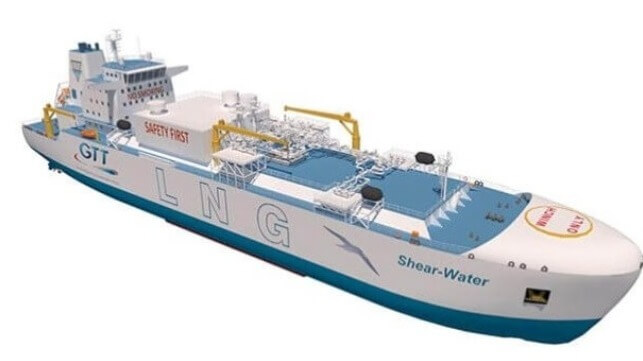Design Approved for Ballast-Free LNG Bunker and Feeder Vessel

France’s GTT (Gaztransport & Technigaz), which specializes in the engineering for liquified natural gas operations, is continuing to make progress with its efforts to develop the first ballast-free LNG bunker and feeder vessel. The company was awarded a new approval in principle from Bureau Veritas for the design concept known as Shear-Water after receiving Approval in Principle from the China Classification Society and DNV in 2021.
The majority of merchant vessels worldwide GTT highlights use ballast water when they are empty or partially loaded to maintain seaworthy conditions. However, they said that even when ballast water is treated, there is a risk of transferring harmful aquatic organisms and pathogens from one area to another.
The solution developed by GTT eliminates the risk associated with ballast water contamination completely. In addition, to removing the need for the ballast water treatment system, the design also reduces the energy consumption and CO2footprint of the vessels.
“This new technological solution allows a reduction in investment and operating costs, simpler operations as well as a reduction in corrosion supporting a longer service life,” said Philippe Berterottière, Chairman and CEO of GTT. “Obtaining this approval by Bureau Veritas constitutes recognition of the ecological relevance and performance of our technological solution.”
The GTT Shear-Water concept is based on the currently proven designs for a vessel with a capacity of 18,700 m3 using two membrane tanks. The design also features a new hull shape, a “V”, which differs from the standard square-shaped mid-ship sections traditionally used for LNG carriers.
“Bureau Veritas has given approval in principle to this new design, which has clear performance and environmental benefits: delimination of the need for ballast water treatment systems and equipment; easier maintenance of the void spaces surrounding the cargo, and reduced propulsion power requirements,” said Mathieu De Tugny, Vice-president of Bureau Veritas.
The companies reported that an exhaustive testing campaign was carried out at the HSVA Hamburg tank test facility in connection with power-speed, maneuverability, and sea-keeping capabilities of the Shear-Water. A sloshing test campaign has also been carried out by GTT to ensure the technical feasibility of the project. According to GTT, excellent results obtained helped approve the concept. Bureau Veritas monitored and reviewed all the test results performed to support its approval in principle.
